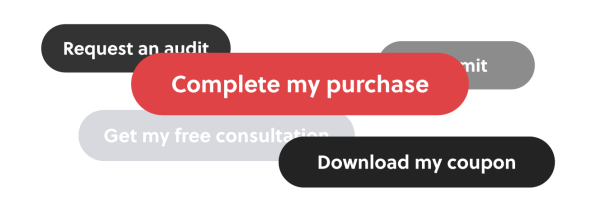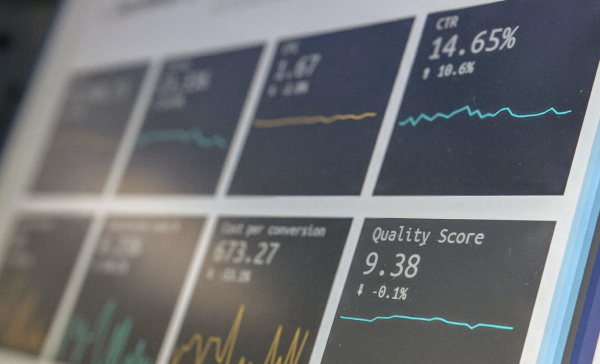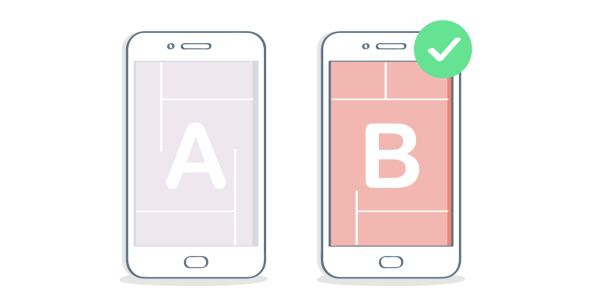What Is Conversion Rate and How To Improve It
by Crystal Clark • February 4, 2022
By Jamison Peterson
Some marketers consider the conversion rate (CR) as the holy grail of metrics, at least as far as quantifying their success is concerned. There’s a reason why that is the case. It’s one of the most reliable ways to measure the performance of advertisements.
In 2020, the top-converting companies spent at least 5% of their budget on conversion rate optimization ( CRO). While five percent may sound small, if you consider how much big corporations spend on advertising, even a single-digit number translates into tens of thousands of dollars.
So why are these companies spending top dollar on conversion rates? Understanding what it is will help make a lot of sense.
What Is Conversion Rate?
CR is defined by the number of conversions on your site divided by the number of visitors. In other words, it’s the percentage of visitors that go ahead and do what you need them to do, for example, buy a product, sign up for a newsletter, or subscribe to a service.
Conversion in itself is defined by your very business and what it sells. More importantly, it depends on what a particular ad’s purpose is.
Say you posted an ad on social media to get people to sign up to receive emails from you to build an organic email list. While you also sell products, and some of these visitors may even go ahead and purchase something from the website, in this instance, the conversion rate is dependent on how many people click on the ad and end up signing up.
Other examples of conversion goals may include downloading software, watching a video, sharing a post, reading an article, filling a survey form, or simply even engaging with your site and spending time on it.

Why Is Conversion Rate Important?
CR is undoubtedly a great way to calculate and assess your marketing efforts and your website or app. The advertisement and marketing are often great, but it’s the actual web page or app that loses the visitor in the middle of the sales funnel.
It can essentially help you identify where the problem is occurring. That, in turn, allows you to improve your website or app and perhaps re-strategize your marketing efforts. CR is measurable data that helps businesses make important decisions.
This metric is also crucial for assessing if you’re getting the return on investment (ROI) in terms of marketing expenditure. However, it’s not the only metric for that, as return on ad spend (ROAS) is even more important.
Nevertheless, a good or bad CR can guide your marketing and advertising efforts, so you’re spending your resources on the most impactful areas and the best way. More importantly, you can optimize the conversion rate for the same traffic and with the same spending. This means that you can increase sales from the same traffic by improving the conversion metrics.
How To Calculate Conversion Rate
The very definition of CR is the conversion rate formula, which is conversions divided by total visitors. To calculate CR, you have to calculate the number of conversions in a given time frame, divide it by the total number of visitors for that time, and multiply the result by 100.
Here’s what the formula looks like: CR = (Conversions/Total Number of Visitors) X 100. Simple right? Here’s an example: If your site got 17,492 visitors and 2,305 ended up converting — performing the action aimed for — your conversion rate is 13.18%. This is, by the way, a very good rate — but more on that later.
The good thing is you don’t need to manually calculate this rate for every campaign you run. Most platforms like Google and Facebook automatically calculate CR as part of the marketing analytics when you enable tracking. CR can also be very specific, which further allows you to refine your marketing efforts and optimize certain areas of your website or business.
Here are some of the different conversion metrics:
- Campaign conversion rate
- Individual ad conversion rate
- Keyword conversion rate
- Marketing channel conversion rate
- Page-level conversion rate
Targeting these specific conversion rates can tell you exactly which improvement to make.
Quality of Data for Calculating Conversion Rates
When it comes to calculating CR, using meaningful data is key. Why is it so important? Suppose you get 100 visitors to your website, and 35 of them convert. Here the CR would be 35%, which is pretty great. However, as you can see, the number of visitors is pretty small. This CR may not show the real picture because the sample set is simply too small.

You have to remember that traffic sources and actual conversions often can have variations like accidental conversions. One way to deal with this problem is to use a longer timeframe for calculation. This will help deal with the anomalies of traffic as well as give you a result that uses a bigger sample size. On the other hand, depending on your business niche and traffic, even a shorter time frame — say, a day — may be enough to evaluate the CR.

What Is a Good Conversion Rate?
CR varies depending on a variety of factors, including but not limited to traffic, traffic source, business size, business model, and timeframe. As you can imagine, this makes it hard to set a benchmark for what qualifies as a good CR. Also, the sales rate may be an even more important metric for some businesses. So even if the CR is good — but sales are low — one may wonder, is it any good?
For learning purposes, here’s an example: Suppose you’re a partner in a law firm that gets $3,500 in revenue for every new customer with a 50% profit margin. You run five different marketing campaigns, with the conversion goal being visitors submitting a lead form.
Here’s what the data looks like.
Campaigns 3 and 4 have the lowest CR at 8%. But we don’t know if, even with a low rate, they have produced any revenue. Now, let’s bring ROI into the fold and see what the data looks like.
As you can see, Campaign 4 has the highest ROI despite having low CR. In hindsight, Campaign 1, which has the best CR, has a lower ROI than campaign 4. The latter put $7.52 in your pocket for every $1 you spent.
This is an example of what qualifies as a good CR. As is common with data analytics, one metric alone may not give you the real story of how your campaigns are doing. It’s all relative to spending and revenue earned from those campaigns you’re calculating the CR for.
How To Optimize Conversion Rate
What is conversion rate? Now that you answer that and know why you should that metric, it’s time to discuss how you can also improve it. CRO is the process of optimizing your landing page or overall website to improve CR. Here are some ways you can optimize your CR, mainly through testing your website and traffic.
Use a Dedicated Landing Page
While you can direct traffic from an advertisement to any page on your website, having a dedicated landing page that is designed to convert can change the game. Many people click on ads but don’t go through the process of buying or converting — whatever that means for you.
While there are many reasons for doing this, the primary one is optimizing it to convert. Landing pages across all industries have an average CR of a whopping 9.7%. Even for sign-up forms, they have a high CR of 23%.

Do A/B Testing
A/B testing is the oldest trick in a digital marketer’s book. This is especially useful when you have different ideas about optimizing conversions.
It’s pretty easy to do it these days with both free and paid tools. All you have to do is create two variants of the web page the traffic is leading two and split the traffic between them. Half of the traffic goes to page A, and half goes to page B, with the same conversion goal.
To do this, you can try the following:
- Google Optimize: This is a free tool for A/B testing. While anyone can use it, the results are not real-time, which means you cannot implement changes quickly.
- Unbounce: This is perfect for A/B testing a landing page. With an incredibly easy interface, it can help you design and test several landing pages rather quickly.
- Optimizely: This is a paid tool, so it has more bells and whistles than Google Optimize and Unbounce. This is more suitable if you have a generous CRO budget.
- Visual Website Optimizer: While this one is also paid, it’s cheaper than Optimizely. It has an easy-to-use intuitive interface, which makes it ideal for newbies.
Identify Target Audience Profile
One of the main reasons your CR may need a booster is that you haven’t done your homework on the target audience. Is your campaign even going to the right audience? Are you using the right tactics to convert them?
Whether it’s the ad copy, images, landing page, or the content on your website, you have to keep in mind the audience to ensure they convert. In simple words, put yourself in their shoes. Here are some important questions you should be asking:
- Have we advertised to this audience before? How was the response?
- What is most important for the audience?
- Where is the audience coming from, desktop or mobile?
- Who are we targeting in particular?
Make sure you know the demographics, age group, expectations, and typical experience with the product or service of your ideal audience. Answer all the questions above, because your responses will provide some really important details that essentially create an audience profile to play off of.
Make the Initial Step Simple and Quick
Many people tend to complete what they have started. It’s just plain human psychology. If you make the initial step of the conversion funnel too demanding, people are not likely to go through. However, if you get them to start by keeping it simple, they might just go through the entire thing.
Consider a long or rather complicated form that you want your audience to fill in. Presenting the entire form just as they land after clicking may put them off, and they may abandon. However, presenting it step-by-step will improve the chances of them filling it to the end. For instance, make the first step collecting name and email address and then move on to the rest of the fields.
This isn’t just limited to forms. This tip can come in handy for other types of conversions as well. Ask for the minimum, to begin with.
Pay for What Works
If you’re optimizing your CR, you’re probably not new to running campaigns and analyzing CR for them. Look at your data so far and identify which campaigns worked, even if very little.
Some things are just not right and don’t work, so it’s in vain to spend your time improving them. If certain strategies have produced poor results in the past, it’s best to let them go. For instance, if a particular traffic source is consistently performing bad, perhaps it’s time to move away from it to the source that has the potential to deliver a better CR. Remember, you can boost CR for the same traffic, and subsequently, improve sales without needing more traffic.
Conclusion
Increasing and optimizing conversion rates for your campaigns can even help you grow your business. Of course, that’s simple math. More conversions mean more revenue. However, as you’ve learned in this article, that’s not always the case.
While your overall CR and those specific ones are important, it’s equally vital to take into account actual sales to correlate conversion and revenue. This is because conversion could be anything from just a click to purchase. However, one thing is certain: CR remains a crucial metric for marketers to get a sense of how their efforts are doing.
If you’re looking to optimize your conversion rate without doing the hard work all by yourself, try out our professional optimization services.





